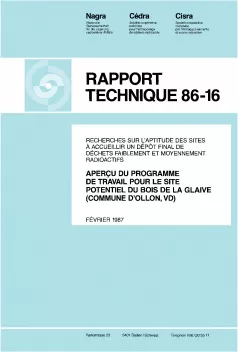
Rapport Technique 86-16
Recherches sur l'apitude des sites à accueillir un dépôt final de déchets faiblement et moyennement radioadctifsAperçu du programme de travail pour le site potentiel du Bois de la Glaive (Commune d'Ollon, VD)
On 30th September 1985, the Federal Government licensed site-suitability investigations in three areas with a view to disposal of low-and intermediate-level radioactive waste. This report gives an outline of the corresponding research programme at the potential site at Bois de la Glaive.
The first part of the report begins with some comments on the concept of radioactive waste disposal and on some basic aspects of site-specific exploration and investigation. The governmental decision of 30th September and Nagra's two-phase investigation concept are then briefly considered. To close, the objectives of investigation phase I are outlined and possible results are briefly discussed.
The research programme developed for the investigation of the potential site at Bois de la Glaive is presented in the second part of the report. Besides geological and hydrogeological investigations at the surface, the programme includes a geophysical survey and the drilling of five to ten piezometers. The planned geophysical investigation consists of eight short geophysical profiles (length 600 to 1500 m) for investigation of the geometry of the gypsum cover on top of the potential host rock (anhydrite) and of two reflection seismic profiles, each 4000 m in length, to study the geometry and the homogeneity of the anhydrite. The purpose of these investigations is to verify, in a first phase, the geological forecasts that have been taken as a basis for selecting the potential site at Bois de la Glaive. The aim of the piezometers is to provide basic data on the alluvial fill of the Rhone plain.
The following sections are devoted to possible additional work and the time-planning of investigation phase I.
The third part of the report gives a brief overview of the most important investigations in the research programmes for the other two potential sites, Oberbauenstock and Piz Pian Grand.
